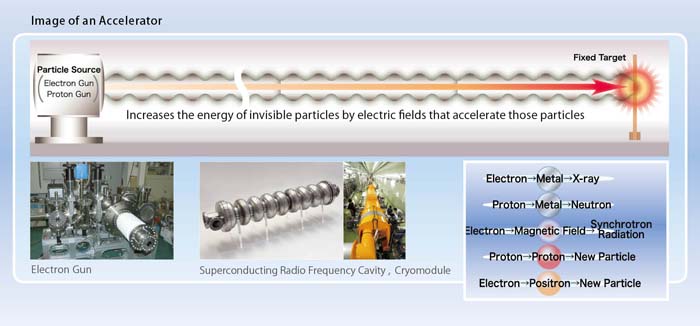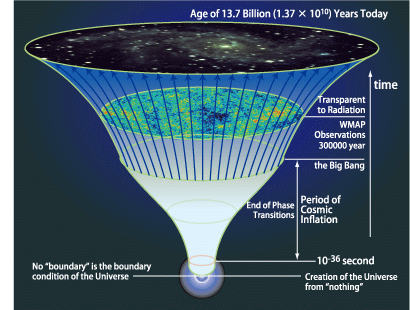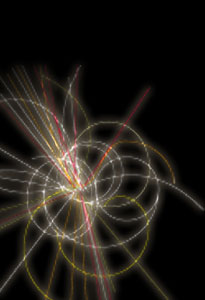
Affluent Future with Advanced Accelerator Science & Technology
An accelerator is a device which creates a state of ultra-high energy by accelerating tiny particles (invisible to human eyes) to nearly the speed of light. "Advanced accelerator" excells in developing its performance and capacity to the max with the latest technologies available today.

◎ Observing Tiny Objects
An accelerator is a big microscope. An electron microscope is also a type of accelerator that uses an electron beam to illuminate a specimen and create a highly-magnified image.
◎ Creating New Drugs
We can study protein structures by utilizing synchrotron radiation technologies. Scientific elucidation of their structures would lead us to epochal drug discoveries.
◎ Examining Inner Conditions
X-rays and neutron beams allow us to investigate conditions of cracks inside walls and pipes, or inner structure of an engine in operation (non-destructive testing (NDT)).
◎ Protecting Our Lives

Accelerators manufacturer diagnostic medicines for PET (Positron Emission Tomography) technologies. X-rays or particle beams emitted from accelerators are also used in the field of cancer treatments.
◎ Discovering Scientific Facts

Today we believe that particles will be discovered when ultra-high energy collisions occur among protons or between electrons and positrons. We are expecting to reveal remarkable scientific discoveries by studying those yet to be discovered particles.
◎ Energy: Effective Use of Light Energy

Photosynthetic reaction center of leaves are critical during the first stage of photosynthesis. Those proteins absorb light in a flash of 100 femtoseconds (10-13 of a second), then convert the light energy into chemical energy.
Photographing (or burst shooting) the reaction with ultrashort pulses of next generation X-rays (XFEL/ERL) at ultra-high speed will enable us to reveal the detailed mechanism of photosynthetic reaction center complex proteins and to develop highly effective solar energy systems.
◎ Environment: Shorten Isolation Period for Radioactive Substances

Some radioactive wastes have lives lasting for tens of thousands of years. An accelerator-driven system (ADS), a reactor coupled to a particle accelerator to produce spallation neutrons, enables us to shorten the time for disposal of high-level radioactive waste from tens of thousands of years down to hundreds of years by bombering neutrons onto long-lived radionuclides to transmute them into short-lived radionuclides.
◎ New Materials and Biotechnology

Particles produced by accelerators are used to change properties of materials. The technology has been applied to develop new materials and methods for selective breeding in industrial and agricultural fields. For instance plant mutations can be generated by exposure to heavy ionizing beams extrac ted from an accelerator. Accelerator-driven genetic mutation provides a higher DNA mutation rate and offers less time to implement selective plant breeding.
◎ Basic Science: Recreating the Initial State of the Big Bang

© Katsuhiko Sato
Today we believe that the Universe was born from a huge explosion called the Big Bang. Advanced accelerators can provide particles with ultra-high energy that is much higher than ever before, enabling us to reproduce the initial state of the Universe approximately 10-12 second af ter the Big Bang. Reproducing and observing the state of the Big Bang will allow us to unlock some of the deepest mysteries of mankind: how the matter in the Universe was created and how the nature's laws have developed over 13.7 billion years.
